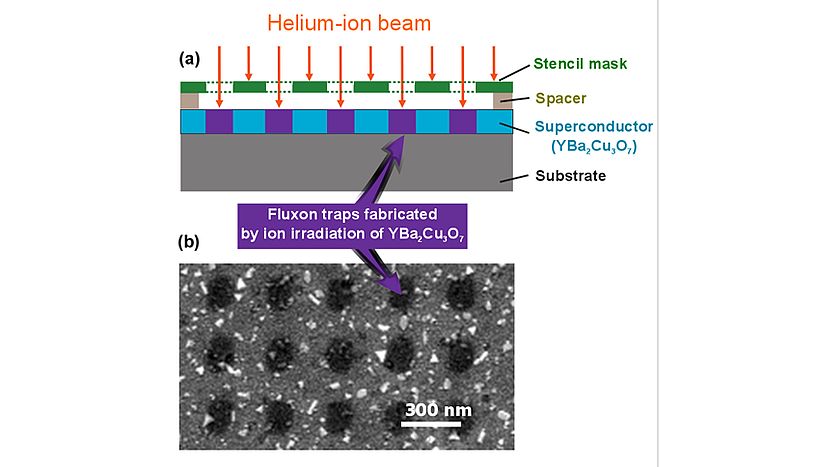Jul 26 2017
“Fluxons,” which are magnetic quantum objects found in superconductors, are specifically appropriate for storing and processing data bits. Computer circuits formed on the basis of fluxons can function at considerably high speeds and also reduce the amount of heat dissipation.
At present, Wolfgang Lang from the University of Vienna and fellow Physicists as well as their Collaborators from the Johannes-Kepler-University Linz have been successful in developing a “quantum egg-box” by employing an innovative and uncomplicated technique. They achieved a regular and stable distribution of a few hundred thousands of fluxons, which is a revolutionary advancement in the case of circuits formed on the basis of fluxons. The outcomes of the study have been reported in Physical Review Applied, a new journal published by the esteemed American Physical Society.
 The principle of the fabrication of a “quantum egg-box” with a novel masked ion-beam technology, developed by the researchers. It allows to produce at the same time hundreds of thousands of traps for fluxons, magnetic flux quanta, in a superconductor. (Credit: University of Vienna)
The principle of the fabrication of a “quantum egg-box” with a novel masked ion-beam technology, developed by the researchers. It allows to produce at the same time hundreds of thousands of traps for fluxons, magnetic flux quanta, in a superconductor. (Credit: University of Vienna)
When data processing in computers is accelerated, it results in considerably high heat generation, restricting the performance of fast computers. Hence, for many years now, Scientists have been attempting to create digital circuits that are based on superconductors. Superconductors are complex materials with the ability to transport electric current without loss if they are cooled to less than a specific critical temperature.
Magnetic quantum objects in superconductors
A magnetic field can prevail inside a superconductor only in tiny quantized pieces, or fluxons, which are specifically appropriate for storing and processing data bits. In the case of a homogeneous superconductor, the fluxons are distributed in a hexagonal lattice. The Scientists from the University of Vienna and the Johannes-Kepler-University Linz employed advanced nanotechnology technique and have been successful in developing artificial traps for fluxons, which force the fluxons to get arranged in a predetermined pattern.
The importance of the non-equilibrium
To date, the Researchers were able to observe the fluxons only in a thermodynamic equilibrium, that is, a uniform distribution.
If we try to stack two eggs on top of each other in an egg-box and leave the adjacent pit empty, the egg would quickly roll down and we end up in the equilibrium state with exactly one egg in each pit.
Wolfgang Lang, the University of Vienna
Yet, with regard to data processing, the completely filled egg-box comprises very less information and hence not so useful. Arranging the eggs in a predetermined formation will be highly useful. For instance, in this manner, the QR code identified by smartphones can be registered in an egg-box, which is evidently a greater volume of information.
At nanoscale levels, the Scientists have, at present, got a significant step closer to achieving this by discovering, for the first time, fluxons existing in a stable non-equilibrium state in an array of over 180,000 artificial traps. Based on the external magnetic field, the fluxons distribute themselves in terraced zones. In these zones each trap captures zero fluxons, accurately one fluxon, or even many number of fluxons.
Even after days, we have observed precisely the same arrangement of fluxons—a long-term stability that is rather surprising for a quantum system.
Georg Zechner, the University of Vienna, who is the Lead Author of the research
Nanopatterning of superconductors by ion beams
The research outcomes were a result of an innovative technique developed by the Physicists from Linz and Vienna in collaboration with the Vienna-based high-tech company IMS Nanofabrication AG.
Masked ion-beam irradiation allows for the fabrication of nanostructures in superconductors in a single step. It can be applied time-efficiently to large areas, can be ramped-up to an industrial scale and does not require any chemical processes.
Johannes D. Pedarnig from the Institute of Applied Physics, the Johannes-Kepler-University Linz
Based on the type of mask used, practically any required structure can be patterned inside the superconductor. At present, the Researchers have proposed to perform more experiments on highly sophisticated nanostructures, which are believed to throw light on systematic transfer of fluxons from one trap to another. This can prove be yet other initiative in developing of faster computer circuits based on fluxons.